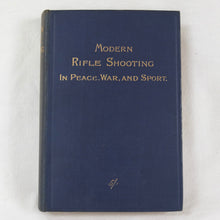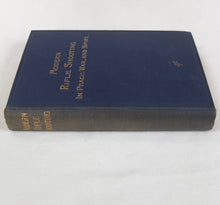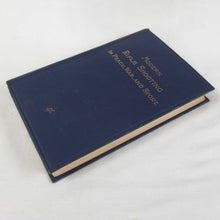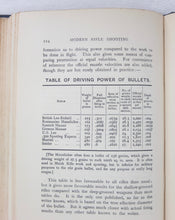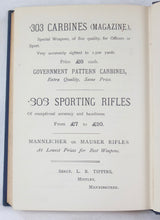Rifle Shooting in Peace, War and Sport
Price
$0.00
Sale
MODERN RIFLE SHOOTING IN PEACE, WAR, AND SPORT
L. R. Tippins
(2nd V.B. Essex Regiment)
J. S. PHILLIPS, Fleet St, London, 1900'In field work a man has to judiciously combine two things. He has to avoid, as far as is practicable, getting hit, and he has to damage the enemy as much as possible. To kill without being killed is the great art of war.'
A very rare Boer War era rifle shooting handbook, written by L. R. Tippins and published by J. S. Phillips of London in 1900. Luke Tippins was recognised as one of the foremost British authorities on rifles and shooting. Rifle Shooting was based on the author’s earlier work of 1895 and was intended as a practical manual for the use of Volunteer Corps battalions. This revised edition of 1900 was published because the newly-adopted Lee-Metford rifle had rendered the earlier manual obsolete. This edition includes a great deal of information on rifle ballistics, range shooting, the effects of various types of bullet, and a comparison of modern magazine fed and other service rifles, such as the Lee-Metford, Lee-Enfield and Martini-Henry. Even though by 1900 the magazine rifle was only just starting to dominate the battlefield, Tippins accurately predicted that the automatic rifle would soon take over: ‘The rifle of the near future will not be a simple magazine rifle, but an automatic rifle, reloading itself after each shot ready for the next.'The book is signed on the front endpaper by ‘W. E. P. Bastard, Lyneham, 1901’. Lt-Col William Edmund Pollexfen Bastard (b.1864) served with the Royal Engineers during WW1. He was made Lt-Colonel of the Devonshire Fortress Engineers in 1915. In 1923 he was High Sheriff of Devon. Lt-Col Bastard lived at Lyneham House, Yealmpton, Devon. Built in 1716, Lyneham is a grade 1 listed Georgian mansion. I will include copies of Lt-Col Bastard’s London Gazette entries and other documents with the book.
L. R. Tippins: Luke Tippins lived at Mistley on the River Stour. He was the local schoolmaster, but his interest in rifles and ballistics led him to leave this profession and become a full time gunsmith. In 1910 he was described as 'a skilled "International" shot, who has very exceptional facilities for experimental work. His knowledge of applied science, joined to long experience of rifle-making, has placed him in the front rank of rifle experts'.
Luke's son John Tippins (1887-1914) was also an expert marksman who won the National Service Rifle Championship in 1911. In a poll taken around 1912, John Tippins was voted by his peers to be among the 10 best marksmen in the world. John Tippins volunteered for overseas service at the outbreak of WW1, only to be killed in November 1914, shot through the heart while fetching water for a machine gun. On the night he fell, he had gone to get water for his Maxim gun, as it was a dangerous job in daylight, and was killed on his return. His commanding officer, Captain Binstead, wrote: 'He had already gained for himself a reputation as a daring sniper and splendid shot, which had spread far beyond his own regiment, and which had he not been shot, would, I feel, have obtained for him a coveted distinction'
Condition:
In very good condition. The boards are in very good condition, with only minor signs of use and some fading to the spine. The binding and hinges are very good and secure. The text is in very good condition. Signed on the front endpaper by ‘W. E. P. Bastard, Lyneham, 1901’.
Published: 1900
Blue boards with gilt titling
Dimensions: 130mm x 190mm
Pages: 274

